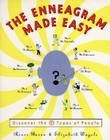Books

Baron, Renee, and Wagele, Elizabeth
The Enneagram Made Easy: Discover the 9 Types of People
New York: HarperCollins, 1994
This overview gives light-hearted coverage of the essential components of the Enneagram of Personality Types. Complete with cartoons!

Chestnut, Beatrice
The Complete Enneagram: 27 Paths to Greater Self-Knowledge
Berkeley, California: She Writes Press, 2013
For each of the nine Enneagram types, Chestnut offers an expanded view on the three subtypes (instinctual biases or goals): self-preservation, social interaction, and sexual (one-on-one) bonding. The widely held premise is that though all three instincts operate in all of us, usually one will be dominant in an individual. This idea consequently contributes to the explanation for different "flavors" of an Enneagram type.

Palmer, Helen
The Enneagram: Understanding Yourself and the Others in Your Life
New York: HarperOne, 1988
One of the foremost instructors of the Enneagram utilizes narratives gleaned from panel discussions to not only present an overview but to focus on type-based patterns of attention and intuition.

Palmer, Helen
The Enneagram in Love & Work: Understanding Your Intimate & Business Relationships
New York: HarperOne, 1995
Palmer gives another fairly comprehensive overview with a focus on how types come together in love and work.

Riso, Don, and Hudson, Russ
Personality Types: Using the Enneagram for Self-Discovery
New York: Houghton Mifflin, 1996
Two internationally-recognized scholars and writers offer a comprehensive coverage of the Enneagram, including an expansive discussion of its origins and history.

Riso, Don, and Hudson, Russ
The Wisdom of the Enneagram: The Complete Guide to Psychological and Spiritual Growth for the Nine Personality Types
New York: Bantam Books, 1999
The authors offer another overview of the Enneagram along with an emphasis on awareness, presence, and the Spiritual Journey.

Riso, Don, and Hudson, Russ
Understanding the Enneagram: The Practical Guide to Personality Types
Boston, New York: Houghton Mifflin, 2000
The authors offer another overview of the Enneagram along with misidentifications, Levels of Development summaries, imbalances of the centers, psychological categories (DSM), each type's "missing piece", and recommendations.

Wagele, Elizabeth, and Stabb, Ingrid
The Career Within You: How To Find the Perfect Job for Your Personality
HarperOne, 2009
The authors suggest that the inherent qualities and acquired traits of the Enneagram personalities can be used to determine "good fit" work solutions.

Wyman, Pat
Three Keys To Self-Understanding: An Innovative and Effective Combination of the Myers-Briggs Type Indicator Assessment Tool, the Enneagram and Inner-Child Healing
Gainesville, Florida: Center for Application of Psychological Type, Inc., 2001
Wyman offers abbreviated explanations of both the MBTI and the Enneagram (one chapter each) and an interesting perspective on how both are integral in understanding self. Discounting any emphasis on wings, subtypes, or degree or level of mental health or spiritual state, Wyman presents her own theory on why individuals operating out of the same Enneagram number can appear to be so different: differing Core Selves as profiled by the MBTI assessment. She proposes that internal tension and conflict results from incompatible qualities of one's Myers-Briggs type and Enneagram type. As a psychotherapist working almost entirely with women, she believes the only way to resolve the tension and conflict is through Inner-Child Healing (which she discusses at greater length). Wyman presents many tragic case studies, but manages to remain witty as well as pointed in her overall writing style.
 SUPPORT! your local library. It's a great place to begin your search for books. The more libraries are used, the more they will be funded.
SUPPORT! your local library. It's a great place to begin your search for books. The more libraries are used, the more they will be funded.
For general purchases, please SUPPORT! your local, independent bookstores; they not only offer committed, informed personnel, but also help preserve the integrity of our downtowns, making them unique and spirit-filled places for meeting our needs for face-to-face interaction.
SUPPORT! Common Good Learning by ordering through links on this website.










 SUPPORT! your local library. It's a great place to begin your search for books. The more libraries are used, the more they will be funded.
SUPPORT! your local library. It's a great place to begin your search for books. The more libraries are used, the more they will be funded.
